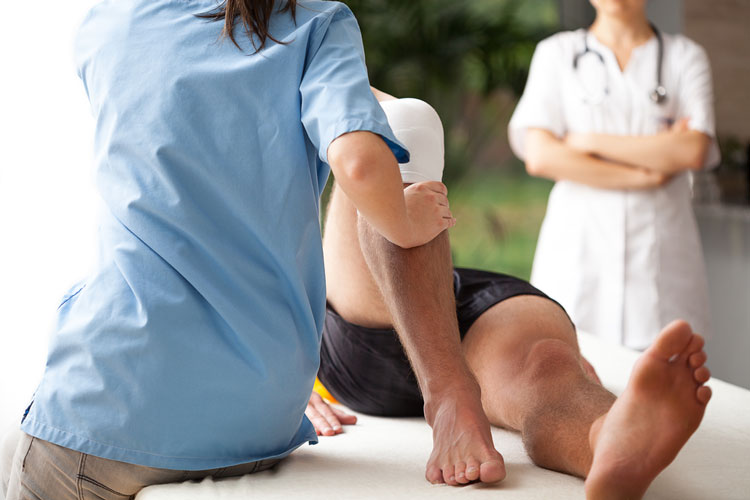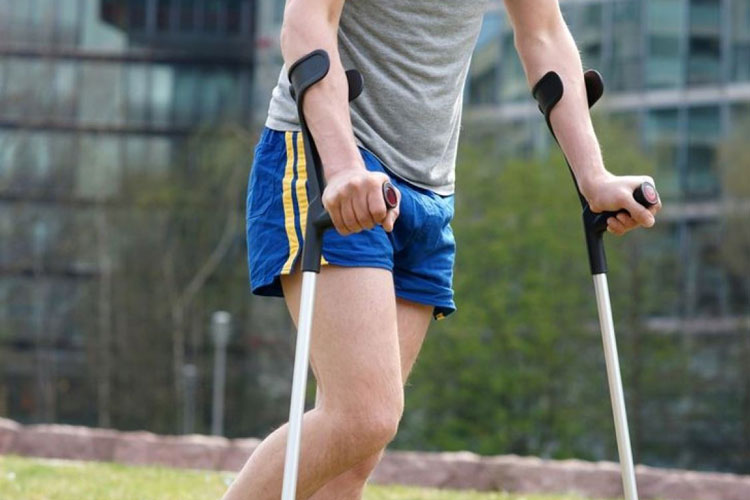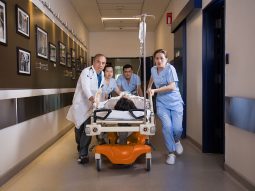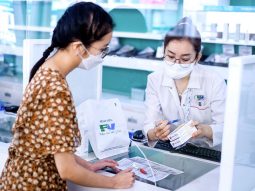If you plan to undergo, or have just had surgery to reconstruct your Anterior Cruciate Ligament (ACL), this brochure explains how an appropriate rehabilitation programme will help to optimise the recovery of your knee function so that you can return safely to your sport and daily activities. You will also find useful information on how to prevent further damage of your knee, including the cartilage, meniscus or other ligaments. While there are several different ACL reconstruction procedures, this booklet describes rehabilitation for the most common ACL reconstruction using a hamstring autograft.

DO I NEED REHABILITATION PRIOR TO SURGERY?
Before proceeding with surgery, rehabilitation is important to help reduce knee pain and swelling, to restore a functional range of motion and strength, to recover your natural gait and learn to walk with crutches. This preparation will help you to recover more quickly following ACL reconstruction surgery. Along with rehabilitation, your physiotherapist may recommend low impact activities such as cycling, swimming and using a cross trainer and treadmill to improve your cardio pulmonary function.
WHY SHOULD I UNDERGO REHABILITATION AFTER ACL SURGERY?
After surgery, your knee graft requires around nine weeks to heal. An appropriate rehabilitation programme will help to protect this graft during the healing process, reduce your pain and ensure that you recover your mobility, strength, full knee function and independence sooner. Through gait pattern and balance training, rehabilitation will also help you to return safely to your sports activities at your former level of fitness.
WHEN SHOULD I START REHABILITATION DURING HOSPITALISATION?
Once you are hospitalised, your rehabilitation programme will start on the day of surgery and continues on a daily basis until you are discharged. Your physiotherapist will help you to promote the healing process through pain and swelling control with cold compression therapy, simultaneously performing pain-free early knee mobilisation using the Continuous Passive Motion (CPM) device. Your physiotherapist will also teach you how to protect your graft with quad strengthening exercises, practice gait training with crutches and assist you in negotiating stairs with crutches. You will be authorised to be partially weight bearing on your operated leg and you won’t wear a knee brace unless recommended by your surgeon.
Below are some exercises that you will do with your physiotherapist and which should be continued once you return home.
1. Ankle pumps and ankle circles: To maintain calf circulation and prevent blood clots, move the foot up and down 10 times, then rotate the ankle, clockwise, then counter-clockwise, 10 times each way. Perform two sets.
2. Quad sets: Place a rolled towel under your knee, with your foot flexed, to contract your quadriceps. Hold for 10 seconds and relax for 10 seconds. Do 10 repetitions. Perform two sets.
3. Heel slide: Gradually bend your knee up to 90 degrees, hold for 10 seconds, then straighten your knee and relax for 10 seconds. Do 10 repetitions. Perform two sets.
4. Knee bends: Sit at the edge of the bed with your operated leg straight and fully supported by your good leg. then let your operated knee bend down slightly controlled by your good leg To return to a straight-leg position, straighten your good leg, thereby straightening the operated leg resting on it. Do not extend your operated leg with the foot unsupported. Do 10 repetitions.
5. Straight leg raise: Keep your operated leg straight and raise it off the bed. Hold for six seconds, then, relax back on the bed for six seconds. Do 10 repetitions. Perform three sets.

HOW SHOULD I COPE WITH PAIN AND SWELLING?
The key to managing pain and swelling is to stay ahead of both.
From the day of surgery, your physiotherapist will help you to control your pain and swelling with medication-free techniques while accelerating your recovery. The most common techniques include a well-adjusted level of activity and RICE:
- Rest
- Ice
- Compression
- Elevation
Do not hesitate to tell your physiotherapist if you experience any acute pain during your rehabilitation.
AM I AT RISK OF FALLS?
During your recovery following ACL reconstruction surgery, your leg will be weak and you may be unsteady. You are at risk of falling until you have recovered your leg strength and mobility. To limit the risk of a fall, you should:
- Use your crutches as recommended and properly maintain the rubber tips;
- Go up and down stairs as recommended by your physiotherapist;
- Avoid wet floors;
- Exercise caution when moving around rugs, cords on the floor and pets;
- Wear well-fitting rubber soled shoes;
- Ensure there is good lighting in your bathroom, corridor and bedroom when performing your night routine;
- Ask for assistance if you feel dizzy or tired.
WHAT PRECAUTIONS SHOULD I TAKE FOLLOWING ACL RECONSTRUCTION SURGERY?
After ACL reconstruction your graft need time to heal.
- Respect the instructions given by your surgeon and your physiotherapist.
- Do not put more weight on your operated leg than instructed by your surgeon.
- Always use your crutches until your physiotherapist approves advancement.
- Do not bend your operated knee more than recommended.
- Lock and control your knee from heel strike during your whole stance.
- Do not twist or pivot your operated leg when turning your body.
- Do not cross your legs when sitting.
- Use stairs as instructed by your physiotherapist.
- Do not lift weight.
WHEN SHOULD I RETURN TO WORK OR TO SCHOOL?
If you have an office job, you will be able to return to work as soon as your knee pain and swelling has lessened, typically two to three weeks after the surgery. For heavy work requiring lifting, squatting or plenty of walking, plan to return to work around six weeks to two months following surgery.
If you are a student, you will be able to return to class within two or three weeks after surgery. As your rehabilitation programme progresses, your physiotherapist will recommend activities such as cycling, table tennis or swimming. You should not play sports until otherwise recommended by your surgeon or your physiotherapist.
WHEN CAN I START DRIVING OR TRAVELLING?
You are recommended not to drive your car or your motorbike until your physiotherapist has authorised you to remove your crutches and you have recovered enough knee control and strength. Usually, you can begin driving again within four to eight weeks after surgery, sometimes later if you have had surgery on your right knee.
Prolonged periods of sitting in airplanes may increase the risk of knee swelling and deep vein thrombosis. If you have to fly, tell your surgeon and plan to wear a compression sock and keep the leg elevated during the flight.

WHAT SHOULD I DO FROM MY DISCHARGE DAY UNTIL THE END OF WEEK TWO?
Until the end of week two, you should continue to be partial weight bearing on your operated leg and walk with two crutches. You should continue the exercises provided at discharge and continue to correct your gait pattern with crutches, ensuring a straight knee during the stance stage and bend your knee during the swing stage. You can take frequent short walks, but you should avoid long periods of standing, sitting or walking as your knee may be at risk of swelling. To reduce pain and swelling, keep your leg elevated as you rest or sit, perform quad contractions and continue to apply an ice pack four to six times a day as per your physiotherapist’s recommendation.
Your physiotherapist will gradually increase your exercises as long as your knee pain and swelling are under control.
WHAT SHOULD I DO FROM WEEK TWO TO WEEK SIX?
During this stage, you may continue to apply ice packs to control pain and swelling. Your physiotherapist will increase the level of your strengthening and stretching exercises. You may be authorised to progress to full weight bearing using your crutches.
Your physiotherapist will advise you when to remove your crutches, at which time you will be able to actively control the full extension of your knee and have a well-balanced gait. The range of your knee flexion should be maintained at around ninety degrees to protect your knee graft, as this will remain weak at week six.
You will progress to different exercises with your foot remaining in contact with a surface, known as closed kinetic chain exercises, including a mini-squat, calf raise, bridge, forward and side steps. To recover your balance, you will start exercises on both legs than progress to one leg . When you are ready, your physiotherapist will recommend that you start using the stationary bike, first moving the pedals through a partial cycle with no resistance before progressing gradually to full cycles. Walking exercises will be increased while the use of crutches is progressively discontinued. Walking exercises can be also performed in a swimming pool according to your physiotherapist’s recommendation.
CAUTION: Straightening the knee with the foot in free motion, also called open kinetic chain, is not authorised until at least the third month following surgery.
WHAT DOES MY REHABILITATION PROGRAMME INCLUDE FROM WEEK SIX TO THE THIRD MONTH FOLLOWING SURGERY?
From week six, your confidence in your knee will increase, however, you should continue to protect your graft as it heals and take great care to maintain a safe daily routine and prevent falls. Supervised physiotherapy should be continued as, at this stage, you must build up your leg strength and improve your balance and leg coordination. The knee range of motion will improve to an unforced full range of motion. At this stage, you should continue to avoid twisting your knee, pivoting and jumping, and strengthen your muscles through open kinetic chain exercises.
Along with your rehabilitation programme, your physiotherapist will recommend that you work on your fitness by performing cardiovascular exercises, including strengthening and stretching. This programme should include using leg press, treadmill, rowing, cross-training and stepper equipment.
Swimming free style or backstroke, kicking your legs in a scissor motion, is recommended. Do not practice breaststroke or butterfly stroke.

WHAT DOES MY REHABILITATION PROGRAMME INCLUDE FROM THE THIRD TO THE SIXTH MONTH AFTER SURGERY?
When you have recovered your knee’s full range of motion, your knee is strong with no swelling and you can balance unsupported in a single leg stance, you will be able to start advanced rehabilitation with your physiotherapist.
Your rehabilitation programme will be adjusted according to your expectations and fitness level. At this time, you may also return to light, non-competitive sports activities. Your follow-up programme will be focused on being able to sit on your heels, increasing the depth of your squat, agility drills and plyometric exercises. You should not experience any pain in your patella during your practice.
Your physiotherapist will guide you as you begin jogging and ball exercises. You should be able to jog for 30 minutes, pain-free, prior to starting running with speed changes. At this stage, closed kinetic chain exercises are continued and open kinetic chain can be started progressively. Do not progress with activities such as jogging, running, agility drills or plyometric exercises if you experience pain or swelling. Share your experience with your physiotherapist so that your level of practice can be adjusted for your body mechanics.
WHAT HAPPENS SIX MONTHS AFTER SURGERY?
At the six-month mark, your knee function should be normal and you can perform all of your usual daily activities. You should have no pain or swelling and your leg strength should be around 95 per cent of that of your non-operative leg. As you recover your confidence, you may practice pivoting, box jumps, bounding exercises and depth jumps (jumping off a box, and then rebounding).
In all cases, avoid returning to sport if you don’t feel ready and have not completed your rehabilitation programme with your physiotherapist. Do not return to sport if you experience anterior knee pain after exercising and recheck your practice with your physiotherapist.
WHAT CAN I DO TO HELP MY RECOVERY?
Your recovery will progress day by day and your physiotherapist will guide you in increasing your participation during the rehabilitation process. Feel free to share any concerns you may have with your physiotherapist to speed your recovery.
- Exercise as recommended by your physiotherapist. Do not over exercise.
- Remove your crutches only if you have been recommended to do so by your physiotherapist.
- Control your pain prior and after exercise using an ice pack, applying it for no more than 20 minutes.
- Control your activity level depending on your pain. You should be able to exercise pain-free.
- Control swelling by resting and elevating your leg.
WHEN SHOULD I CONTACT MY PHYSIOTHERAPIST?
During or after your rehabilitation programme, do not hesitate to contact your physiotherapist when:
- Your rehabilitation exercises increase pain;
- You don’t feel confident on your knee or feel unstable;
- You would like to adjust or increase your exercises.
For further information, please contact
FV Hospital
Physiotherapy & Rehabilitation department
F Building, 1st floor
Email: rehabilitation@fvhospital.com
Tel direct line (028)54 33 33 40
Tel standard (028)54 33 33 33 extensions 1085 or 1485

 Vi
Vi 












